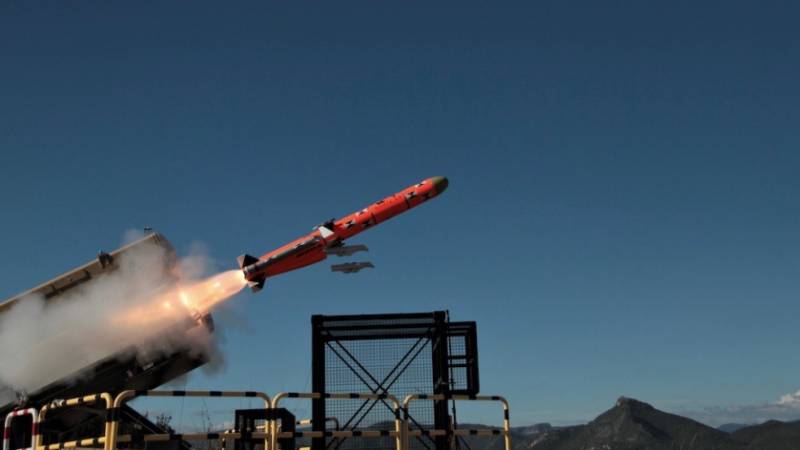The old Italian rocket found a second youth

MBDA has completed the second stage of testing the Marte ER anti-ship missile, test launches were carried out at the PISQ (Poligono Interforze del Salto di Quirra) test site in Sardinia. They confirmed the expected tactical and technical characteristics of the missile, which is the final stage on the way of its modernization before being put into service.
The naval target, a decommissioned Lupo-class frigate, was hit with high accuracy with "almost zero error" after the missile had flown about 100 km. Marte ER during this time performed several dynamic maneuvers, including a long flight at an ultra-low altitude, less than two meters, over the sea at very high speed. Hitting the target confirmed the intended behavior of the projectile.
Mars
Marte ER is the third generation of the Marte family of rocket systems. Derived from the Marte MK2 / S anti-ship missiles, the Marte ER version differs in the use of a small-sized turbojet engine instead of a solid propellant sustainer, which significantly increases the flight range. The Marte ER has the same interfaces and logistical support doctrine as the Marte MK2/S. This means that no equipment changes are required for those carriers that are already adapted for missiles of this family, for example, heavy shipborne helicopters NH90 and AW101.
The Marte family are anti-ship missiles launched from helicopters, aircraft, ships and coastal batteries. Anti-ship missiles commissioned by the Italian Navy have been developed by Contraves Italiana, the Italian subsidiary of the Swiss arms company Oerlikon Contraves since the early 1960s.
The first version of the Sea Killer Mark 1 missile, an anti-ship missile with a range of 10 km, received the export name "Neptune" (Nettuno) and entered service in 1963. In 1965, Contraves Italiana began work on an improved Vulcano rocket that used the same guidance system but was equipped with an additional launch rocket booster that gave it a longer range of 25 kilometers (16 mi). The rocket became heavier, the starting weight is 324 kg. The length of the rocket is 4,7 m, the diameter of the midsection of the rocket is 206 mm, the launch booster is 320 mm. The missile carries a semi-armor-piercing warhead weighing 70 kg.
In 1967, the Italian company Sistel (Sistemi Elettronici) was created as a joint venture of five Italian companies, including Contraves Italiana, and the Contraves Italiana missile division was transferred to Sistel along with Nettuno and Vulcano missiles, in 1969 Nettuno and Vulcano were renamed Sea Killer Mark 1 and 2 respectively for export orders, and these names gradually replaced the old ones, the latest versions received a new name - Marte.
Marte in the airborne version entered service with the Italian Navy in 1977, its main carriers were Sikorsky SH-3 Sea King shipborne helicopters, each helicopter was armed with two Sea Killer Mark 2 missiles.
Mars 2
In 1983, a new version of the Marte 2 was announced, in which the beam guidance system was replaced by the ADAS active radar seeker, which is also used in the Otomat and Exocet anti-ship missiles.
The ADAS GOS is capable of detecting destroyer-class surface targets in sea conditions of 6 points at a distance of 24 km. The operating frequency range of the active radar seeker is 8-10 GHz. The antenna searches for a target in the sector from -16° to +16° and from -10° to +10° in elevation. In the event that the enemy uses effective electronic countermeasures, the GOS can switch to the jamming mode.
When the sea is very rough, it is possible for a rocket to fly over the deck of a ship (especially when it is between waves). In this case, the seeker performs the functions of a radio fuse, ensuring the detonation of the warhead above the deck. Autonomous flight is carried out at extremely low altitude using the AHV-7 radio altimeter, operating in the mode of continuous radiation with frequency modulation.
Tests of the Marte 2 began in 1984, and the missile entered service with the Italian Navy in 1987. The MBDA company in the 1990s absorbed all the small European developers and manufacturers of rocket weapons.
Mars ER
Currently, the Marte ER missile program is developing dynamically, the process of fully integrating Marte ER with Eurofighter Typhoon aircraft is at the final stage, the adaptation of missiles to the fighter will expand the capabilities of the Eurofighter Typhoon to combat surface targets.
The Marte ER is a deeply upgraded missile from its previous generation Marte missile family, the solid propellant propulsion rocket engine has been replaced with a Williams WJ-24-8G WR turbojet engine, increasing range from 25 km to over 100 km (62 miles).
Tests of the first phase of the Marte ER on the NH90 helicopter, which can carry two missiles, took place in June 2014. A larger anti-ship missile such as the Exocet was rejected as the main armament of a helicopter as being physically too bulky and heavy.
Marte-ERP
In November 2015, the Eurofighter Typhoon was tested against fixed wing missiles called Marte-ERP, which do not have folding stabilizers and wings, and also lack a launch booster and are equipped with a new high-explosive fragmentation warhead with a larger mass of up to 120 kg (265 lb) with penetrating properties and the ability to sector undermine.
The Marte-ERP missile, with a launch weight of 315 kg, a length of 3,79 m, is half the size of other options such as Harpoon and RBS-15, while at the same time it has the same maximum range.
The Eurofighter Typhoon can carry six Marte-ERPs (or four with two external fuel tanks) compared to two or three larger missiles.
Information